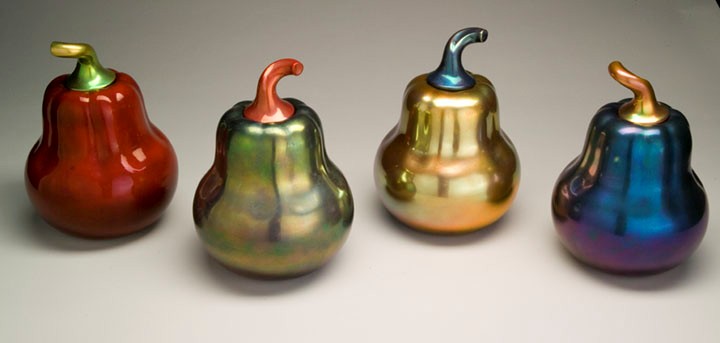I've never had an au pair to lend a helping hand at home, and these days I'm short-staffed at work, like just about every other art museum curator I know. All the more reason to create visual lifts in the galleries I share with our diverse public here at the Baltimore Museum of Art. Every time I quit my office, heading briskly towards yet another meeting, I pass by a set of four iridescent pear-shaped lidded jars. They are in a plexi case hanging over a heavily-carved, somewhat bumptious English court cupboard that once served to display the family silver plate as ostentatiously as possible. The cupboard was made in about 1600, but the pears are quite new. They're the work of Budapest-born Eva Zeisel. Her intent, she says, was to make viewers "rejoice!" The pears never fail to raise a smile.
Zeisel has been designing ceramics since the early 1930s -- first in Hungary, then in Russia, England and America. In 1983 she returned to her native country to create engaging vessels shaped like various fruits and vegetables, including these wonderful pears with their voluptuous curves and slick surfaces. Don't let the pert little stems atop the lids fool you -- only the smallest child could reach into one of these seductive jars and pull out a cookie. So, unlike Zeisel's designs for dinnerware, such as her Century Collection (designed 1952; currently in open stock at Crate and Barrel) the pears are not about eating. They are about looking.
Set of Four Iridescent Jars. Designed in 1983 by Eva Zeisel (American, born Hungary 1906) for Zsolnay Factory, Pécs, Hungary. Glazed porcelain, H: 10 inches. Baltimore Museum of Art, Gift of Brice Brown and Donald Joint, 2006.71.1-4a-b.
Developed at the Zsolnay factory in Pécs, the iridescent glazes reprise early 20th-century formulae for metal-oxide based reduction glazes. And, if you are an art historian (somebody who enjoys looking backward by definition), you might be aware of a rich resonance between Zeisel's pears and much earlier lusterwares -- ceramics with shiny metallic glazes that were created as early as the 9th century in Mesopotamia.
If I had to explain the history of the world in a single word, I'd choose "shopping." Like all good design ideas, lusterware followed the trade routes, spreading round the Fertile Crescent to Egypt, Persia and Syria, then across the Mediterranean to medieval Hispano-Moresque Spain. On they went, north to Italy, France, and England. There were even a few practitioners in the United States. Shortly before Zeisel commenced her own 100-year-plus life journey as an accomplished ceramist, splendid lusterwares were designed by the likes of William De Morgan in England, Clément Massier in France, Ulisse Cantagalli in Italy. At the turn of the twentieth century, Jacques Sicard, a former employee of Massier, briefly made lusterwares at the Weller pottery firm in Zanesville, Ohio -- clear evidence of design as an international phenomenon. Eva Zeisel belongs, then, to an extensive cadre of talented designers; her work is part of a long visual "conversation" over time.
Oh. Pears. More to them than first meets the eye. From time to time I hope to offer readers of this blog some thoughts about the complexities of seemingly simple pieces like these. Zeisel says, "Beauty depends on one single person... who looks at something and feels joy... because it pleases him without second thoughts... Beauty cannot exist without someone to enjoy it."
That could be you.
